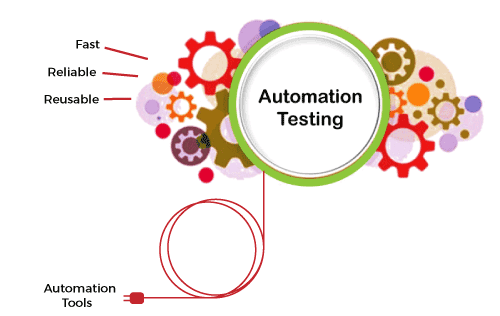Advantages of Automation Testing
In this article, we are going to discuss the advantages of Automation testing.
This post will be very helpful to you and give you complete information about the benefits of automation testing. So, without any delay, let’s start the topic.
Before going to the benefits, let’s first see a brief description of automation testing.
Automation testing
Automation testing uses some specific tools to execute the test scripts without any human interference. In automation testing, the test automation engineer writes the test scripts or uses the automation testing tools to execute the application. Whereas, in manual testing, the test engineer write test cases and implement the software based on written test cases. It is the most acceptable way to enhance the efficiency, productivity, and test coverage of Software testing.

In automation testing, test engineers can execute repeated tasks, whereas repeated execution of tasks in manual testing is a tedious process.
With the help of an automation testing tool, we can easily approach the test data, handle the test implementation, and compares the actual output against the expected outcome.
Automation testing mainly focuses on reducing manual human activity with devices or systems. It increases the efficiency, effectiveness, and coverage of software testing. It saves time and effort. For the proper implementation of automation testing, there is a requirement of considerable money and investment. There are various automation testing tools available in the market, such as – selenium, QTP, Watir, Testim, etc.
Now, let’s discuss the benefits of Automation testing.
Benefits of automation testing

The advantages of automation testing are given as follows –
Saves time
Automating the testing process helps the testing team to use less time to validate newly created features. For instance, in manual testing, there is a need to write thousand test cases for a calculator application, but automation makes the process much faster.
Productivity improvement
As during execution, automation tests do not require human intervention, so testing an application can be done late at night, and we can get the results next morning. Software developers and testers require less time on automation testing.
Accuracy improvement
In manual testing, there is a chance of mistakes whether you are an experienced testing engineer. The chances of errors may increase when testing a complex use case. But Automation testing reduces the chances of errors. There is good accuracy, as we will get the same result each time on performing the same test cases.
Test suite reusability
We can reuse the test scripts in automation testing, and we don’t need to write the new test scripts again and again. These test cases can be used in various ways, as they are reusable. Reusability helps to reduce the cost and also eliminate the chances of human error.
Ability to test on various platforms
Automation testing allows the user to test the application on different web browsers and operating systems.
Running tests 24/7
In automation testing, we can start the testing process from anywhere in the world and anytime we want. It can also be done remotely if we don’t have many approaches or the option to purchase them.
Early bug detection
By automation testing, it is easy to detect critical bugs in the initial phases of software development. It reduces the cost and helps us to spend fewer working hours to fix such problems. It increases the efficiency of the team.
Less human resources
Automation testing requires fewer people to perform a tedious manual test. To implement the automation test script, we need a test automation engineer who can write the test scripts to automate our tests.
Reduce the expenses
Automation testing is less expensive, as once the test scripts have been built, we can reuse them at any time without any extra cost. While manual testing is more expensive than automation, with manual monitoring, it is typical to execute experiments repeatedly.
Scalability of test cases
In manual testing, we require the involvement of the number of people and number of hours to scale up a project. Whereas the scalability of automation testing is higher, we need adding of test executors to the testing framework.
Consistency
Compared to manual testing, automation testing is more consistent and way faster than executing the regular monotonous tests that cannot be missed but may cause faults when tested manually.
Fast development and delivery
Automated tests can be executed repeatedly and completed rapidly. We do not have to wait for weeks to execute the tests; few hours are enough for execution. Switching from manual to automation reduces the waiting time and boosts development.
Easily execution of lengthy and complicated test cases
Execution of bug-prone and complex test cases is easier with automation testing. Test cases with reproducible steps lead to distraction and wrong assurances on testing them manually.
Some of the other benefits of automation testing are listed as follows –
- In comparison to manual testing, automation testing requires fewer resources.
- It makes load and performance testing, stress testing, and reliability testing possible.
- It is more reliable, as it reduces the occurrence of errors. It is reliable because it tests the application with the help of tools and test scripts.
- With automation testing, test engineers are free to focus on other work.
- It improves the testing coverage as the automatic execution of test cases is faster than manual execution.
- Automation testing allows the execution of test cases in a 24×7 environment.
- It enhances the knowledge of test engineers by producing a repository of different test cases.
- Batch execution is possible using automation testing because all the written scripts can be executed simultaneously.
- Automation testing is 70% faster than manual testing.
Conclusion
Automation testing is increasing in software industries. When it is properly implemented, it will have a lot of benefits. It is also kept in mind what tasks are worth automating. The tasks performed a single time should not be automated because the effort needed to automate such tasks usually does not pay off.

Testing is a key area, and applying automation in it will decrease the timelines for SDLC. Using the automation testing tools helps to remove the barriers of manual testing by reducing the development cost and bugs in the application and enhancing the product’s quality.
That’s all about the article. Hope you find it helpful and informative.
